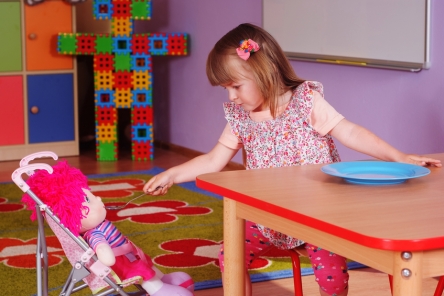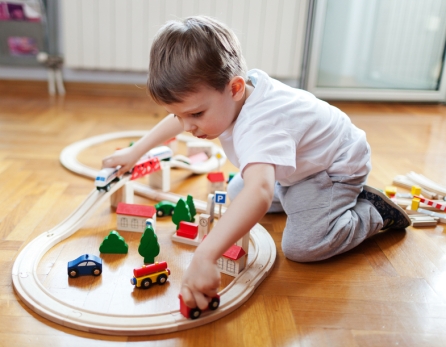 When children play, they develop their knowledge of themselves and others, learn to make sense of the world around them, and learn to communicate with peers and adults. As children grow and develop, play changes, but the importance of it remains. There are a number of ways that educators and other adults can support play for various ages of young learners.
When children play, they develop their knowledge of themselves and others, learn to make sense of the world around them, and learn to communicate with peers and adults. As children grow and develop, play changes, but the importance of it remains. There are a number of ways that educators and other adults can support play for various ages of young learners.
But first, let’s learn how it evolves:
Infants
Infants and toddlers experiment with bodily sensation and motor movements, as well as with objects and people. By the time a child is six months old, he has developed action schemes through practice to make interesting things happen. For example, he will push at toys to make them rattle, roll, or jingle. As babies master new abilities, they will coordinate simple schemes to create more complex play. Older infants will throw a toy and then crawl after it to retrieve it. They apply the same limited action to various toys. For example, they will push various objects, such as a ball, rattle, or stuffed animal, to see how each reacts. By the time a child is twelves months of age, he learns that objects will have different actions. For example, he knows to roll a ball and shake a rattle.
Toddlers
By a child’s second year, she is beginning to understand how toys and objects fit into the social world around her. Toddlers will place a spoon in their mouth and a doll in a stroller. Older toddlers begin to use symbols and will invent objects and roles. For example, they will pretend to feed a baby doll or rock and soothe its cries. Adults can support and initiate such play to encourage learning. Children’s responses should guide adult actions. Encourage children to tell you about their play or play along with them. Even simple social games, such as peek-a-boo, teach children to take turns and appropriately interact with each other.
As children develop this ability to use symbols to represent experiences, pretend play becomes a prominent activity. This more complex type of play involves children carrying out action plans, taking on roles, and transforming objects to express their ideas and feelings. Most often, children create family-related action plans or ways to treat, heal, and avoid threats.
Roles are identities that children assume in their play. Some roles may be necessary for certain themes. For example, healing an illness requires a doctor and patients. Family roles, such as a father and a child, are also popular and are drawn into play with themes familiar to home activities such as cooking, cleaning, or working on a simple project.
Preschoolers
By the time a child is age four or five, his ideas about the social world initiate more pretend play. At this age, play among peers becomes more important. While some play may be solitary or shared with an adult, pretend play is usually shared with other children at school or in the neighborhood. In order to implement and develop pretend play episodes, there must be a great deal of communication and shared meaning negotiated among children. They often make rules to guide behavior. For example, a rule might be, “Baby, go to sleep now.” Children learn to work through potential conflicts and incorporate their wishes into play. For example, a pretend menu might be filled with candy and sweets!
 Construction play is also popular with preschoolers, as they use blocks, toy cars, train sets, and toy people to create situations according to their experiences. Rough-and-tumble play and play with motion and movement occur as well. This play is often performed somewhat aggressively and should be monitored, but nonetheless is appropriate for this stage of development. Action play allows children to build motor skills, teaches them skill in their movements, and they learn to regulate each other’s activity.
Construction play is also popular with preschoolers, as they use blocks, toy cars, train sets, and toy people to create situations according to their experiences. Rough-and-tumble play and play with motion and movement occur as well. This play is often performed somewhat aggressively and should be monitored, but nonetheless is appropriate for this stage of development. Action play allows children to build motor skills, teaches them skill in their movements, and they learn to regulate each other’s activity.
The various stages of play that children learn during the preschool years builds a foundation for more logical and socialized ways of thinking that take place later. This learning needs to happen before they enter school and begin to play games with rules that will be prominent through middle childhood.
So remember, play isn’t just for fun—there is learning taking place too!
Back to blog listing